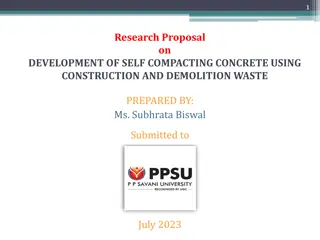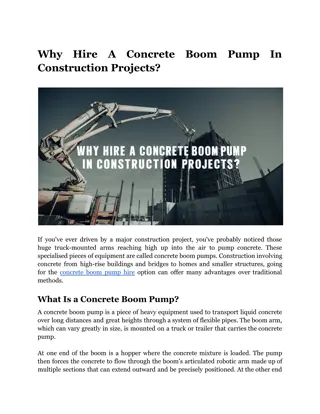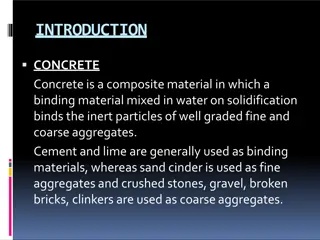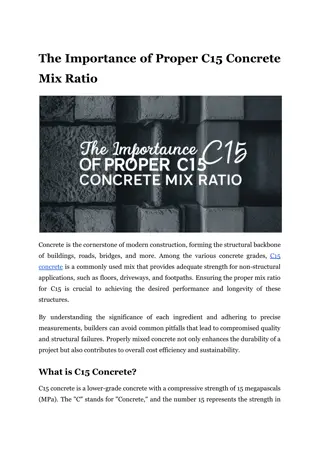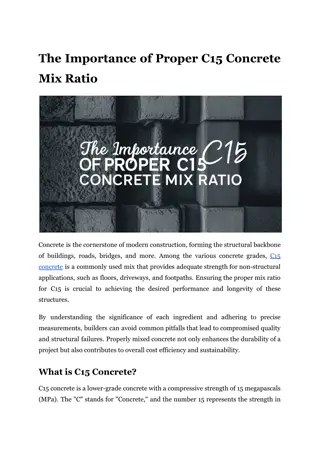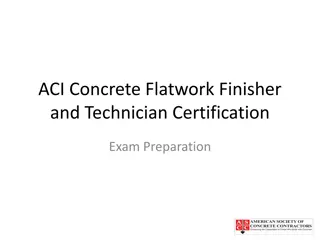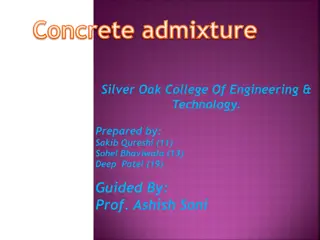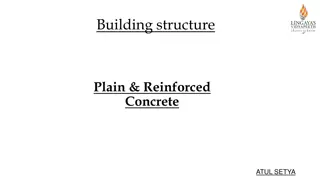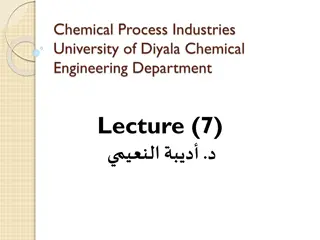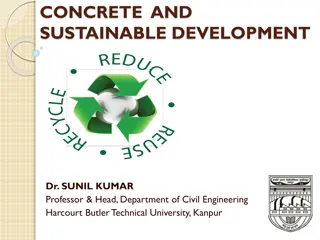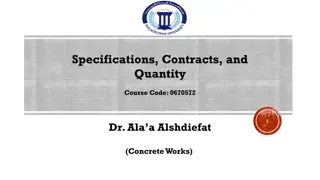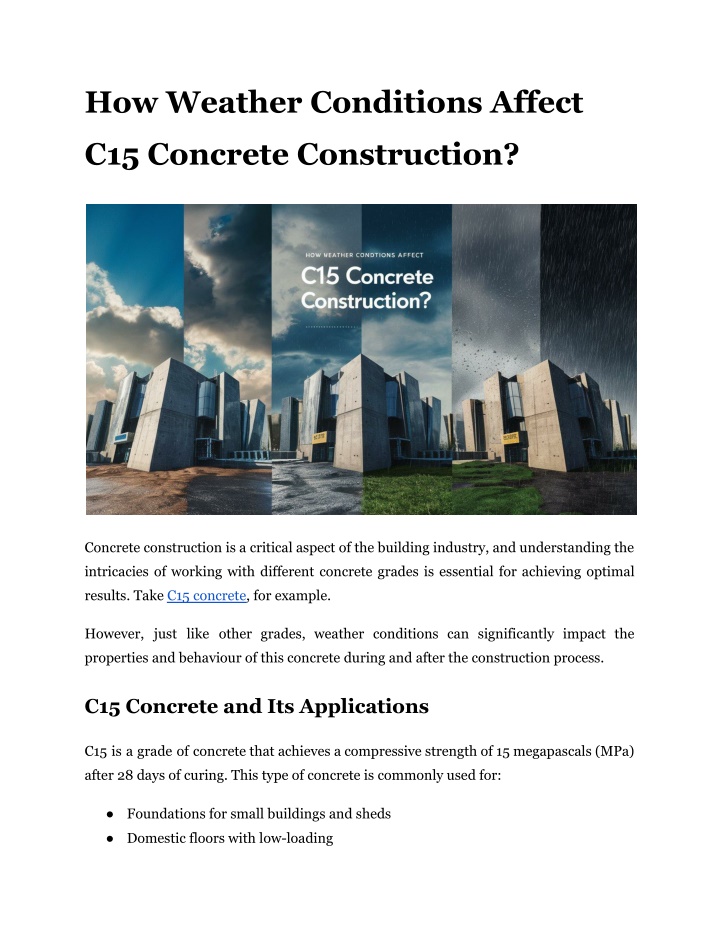
How Weather Conditions Affect C15 Concrete Construction?
Understand how weather conditions affect C15 concrete construction. Learn tips for ensuring quality and durability in varying climates.n
Download Presentation

Please find below an Image/Link to download the presentation.
The content on the website is provided AS IS for your information and personal use only. It may not be sold, licensed, or shared on other websites without obtaining consent from the author. If you encounter any issues during the download, it is possible that the publisher has removed the file from their server.
You are allowed to download the files provided on this website for personal or commercial use, subject to the condition that they are used lawfully. All files are the property of their respective owners.
The content on the website is provided AS IS for your information and personal use only. It may not be sold, licensed, or shared on other websites without obtaining consent from the author.
E N D
Presentation Transcript
How Weather Conditions Affect C15 Concrete Construction? Concrete construction is a critical aspect of the building industry, and understanding the intricacies of working with different concrete grades is essential for achieving optimal results. Take C15 concrete, for example. However, just like other grades, weather conditions can significantly impact the properties and behaviour of this concrete during and after the construction process. C15 Concrete and Its Applications C15 is a grade of concrete that achieves a compressive strength of 15 megapascals (MPa) after 28 days of curing. This type of concrete is commonly used for: Foundations for small buildings and sheds Domestic floors with low-loading
Paving for walkways and patios Non-structural elements like garden walls The C15 Concrete Mix Ratio The performance of C15 is highly dependent on the correct mix ratio. The typical mix ratio for C15 is 1:2:4, which means one part cement, two parts sand, and four parts coarse aggregate. Water is added to achieve the desired workability and consistency. The components of the C15 concrete mix ratio are: Cement: Acts as the binding agent that holds the mix together and provides strength. Sand: Fine aggregate that fills the voids between coarse aggregates and contributes to the workability of the mix. Coarse Aggregate: Provides bulk and contributes to the overall strength of the concrete. Water: Activates the cement and facilitates the chemical reaction (hydration) that allows the concrete to set and harden. Read More Articles: C20 Concrete Mix Ratio Explained: Tips for DIY Enthusiasts The Role of Weather in C15 Concrete Construction Temperature Hot Weather (Above 30 C or 86 F) High temperatures can accelerate the setting time of concrete. This results in potential cracking if proper curing practices aren't followed. To combat this, using chilled water for mixing and implementing curing methods like fogging or wet burlap can significantly improve the hydration process, and you will get stronger concrete.
Cold Weather (Below 5C or 41F) When temperatures dip low, the water in the concrete mix freezes, hindering the hydration process and compromising strength. To address this, cold weather admixtures can be incorporated into the mix to lower the freezing point of water and allow proper hydration at lower temperatures. Additionally, proper insulation of the fresh concrete can be crucial to retain heat. Humidity High Humidity While generally beneficial, excessively humid conditions can lead to slower evaporation of mixing water. What happens next? Potentially affect the setting time and strength development. This can be mitigated by using proper drainage techniques to prevent water accumulation around the curing concrete. Low Humidity Conversely, overly dry conditions can accelerate moisture loss from the concrete. The concrete might have under-par workability and also shrinkage cracks. Implementing proper curing practices, like covering the concrete with plastic sheeting or using curing compounds, becomes even more critical in low-humidity environments. Precipitation Rainfall during or shortly after the concrete pour can wash away the cement paste, which results in a weakened surface. If rain is forecasted, it's best to postpone the concrete pour or implement protective measures like covering the fresh concrete with plastic sheeting.
Wind High winds can exacerbate moisture loss from the concrete surface, particularly in hot or low-humidity conditions. Windbreaks can be used to minimise the impact of wind on the curing process. Read More Articles: Troubleshooting Common Issues with C25 Concrete Mixes and Solutions Best Practices for C15 Concrete in Different Weather Conditions Understanding the weather's influence allows you to take proactive measures during construction. Here are some best practices to ensure optimal C15 performance in various weather conditions: Hot Weather: Schedule concrete pours for cooler mornings or evenings. Use chilled water for mixing. Implement proper curing practices like fogging or wet burlap covers. Consider using admixtures specifically designed for hot weather concreting. Cold Weather: Schedule concrete pours for warmer days whenever possible. Use heated aggregates and mixing water. Incorporate cold weather admixtures into the concrete mix. Insulate the fresh concrete to retain heat. Monitor the curing temperature to ensure proper hydration. High/Low Humidity: Adjust the mix design slightly to account for high humidity conditions. In low humidity, prioritise proper curing practices like covering the concrete or using
Precipitation: If rain is imminent, postpone the concrete pour if possible. If a pour can't be delayed, have a contingency plan in place, such as using tents or other protective covers to shield the fresh concrete. If rain does occur during a pour, stop the concrete placement immediately and cover the exposed concrete as soon as possible. Wind: Schedule concrete pours for calmer days whenever possible. If winds are unavoidable, use windbreaks to minimise the impact on the curing process. Make The Most Of Your Concrete You need to understand how weather conditions affect concrete construction and by implementing the best practices outlined above. This is really how you can significantly increase the chances of a successful and long-lasting concrete project. Remember, a little planning and preparation go a long way in ensuring your C15 concrete performs as intended for years to come. Pro-Mix Concrete is the experienced concrete contractor you need. With a proven track record of success in various weather conditions, we offer expert advice on mixed design, construction techniques, and curing practices. Site Article: How Weather Conditions Affect C15 Concrete Construction?

